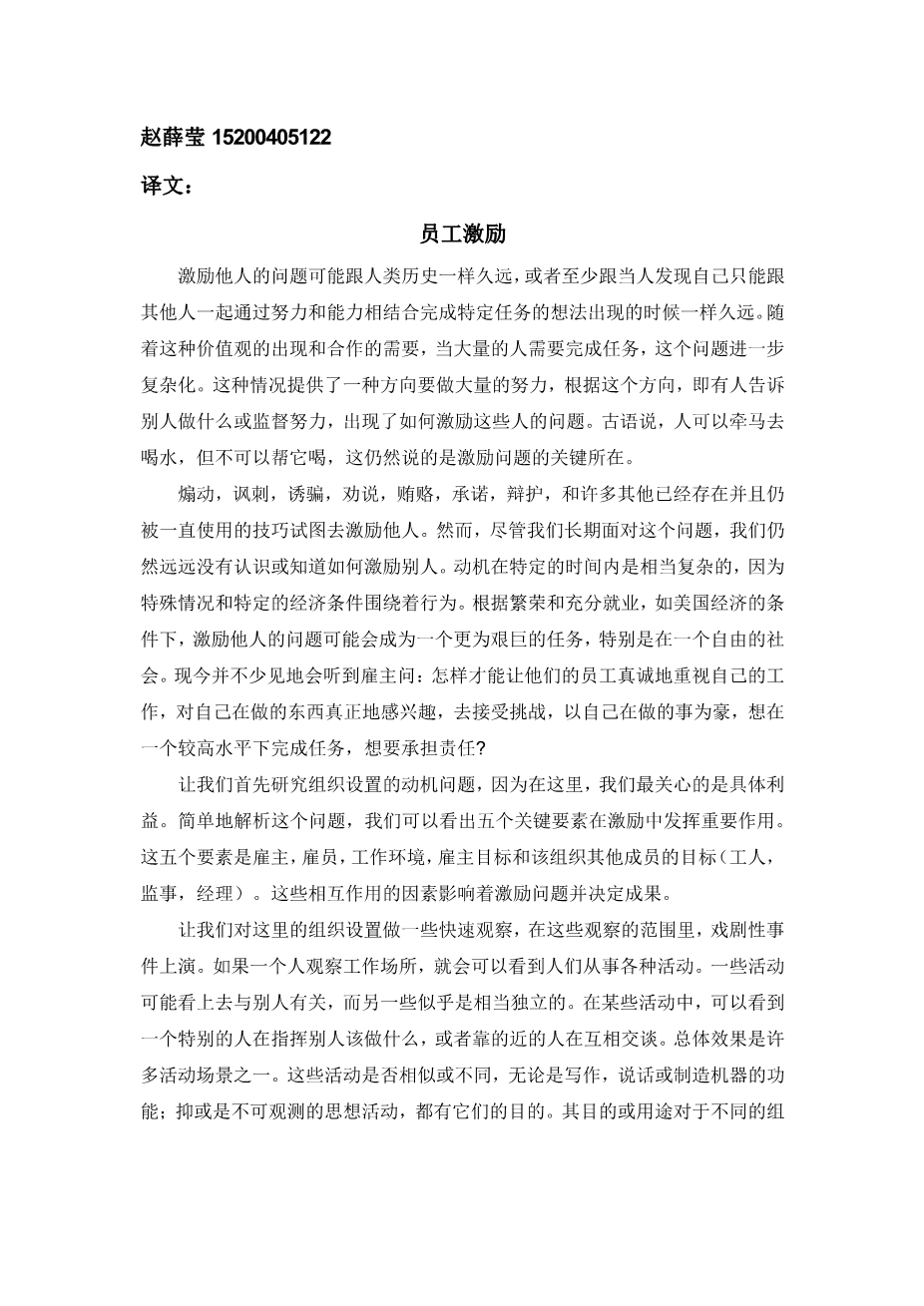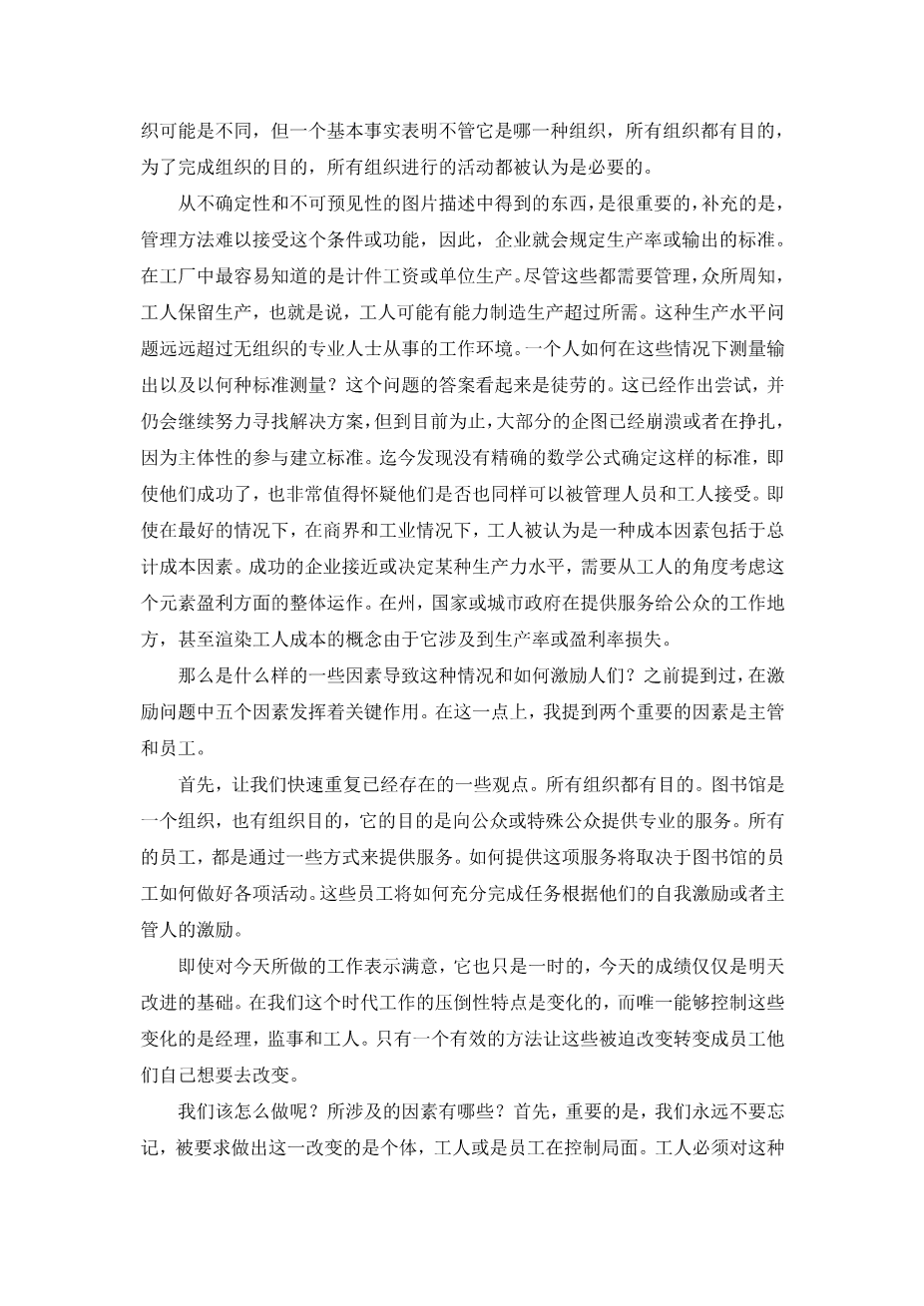赵薛莹员工激励【外文原文】
在线编辑
赵薛莹员工激励【外文原文】
本科毕业论文(设计)
外 文 翻 译
赵薛莹 15200405122
原文:
Employee Motivation
The problem of motivating other people is probably as old as the history of man himself, or at least as old as that point in time when man found he could only accomplish certain tasks by combining his efforts or abilities with those of other individuals. With the onset of this realization of the value and need for cooperative effort, the problem was further compounded when larger numbers of people were needed to accomplish a task. The situation then arose of providing direction to such a multiple effort; and with direction, i.e., someone telling others what to do or overseeing the effort, there came the matter of how to motivate these people. The old saying, one can lead a horse to water but one cannot make him drink, was and remains the crux of the motivation problem.
The whip, the lash, cajolery, persuasion, bribery, promises, pleadings, and numerous other techniques have been and are still being used in an attempt to motivate others. Yet, despite our long confrontation with this problem, we are still far from understanding or knowing how to motivate others. Motivation is a matter further complicated by the particular period of time, the particular circumstances and the par- ticular economic conditions surrounding an act. Under conditions of prosperity and full employment, such as the U.S.A. has experienced, the problem of motivating others may become a far more difficult task, particularly in a free society. It is not uncommon today to hear employers ask: How does one get his employees to be genuinely concerned about their work, to take real interest in what they are doing, to accept challenges, to take pride in what they are doing, to want to accomplish at a high level, to want to assume responsibility?
Let us begin by examining the problem of motivation in an organizational setting, for it is here that our particular interests are most concerned. Analytically and for simplicity's sake, one can discern five key elements which play a major role in motivation. These are the employer, the employee, the work environment, the goals of the employer and the goals of the other members of the organization (the workers, supervisors, and managers). It is the interplay of these factors that influences the problem of motivation and determines the outcome.
Let us then make some quick observations of this organizational setting for it is here, within these bounds, that the drama is played. If one observes the work place, one can see people engaged in a variety of activities. Some of these activities may seem to be related to the activities of others, while others may seem to be quite independent. One catches a glimpse of a particular individual who appears to be telling others what to do, or of other people near each other engaged in conversation, while carrying on some activity. The total effect is one of much activity about the scene. This activity-whether similar or different; whether it is writing, talking or making machines function; or whether it is unobservable activity of thought-all has purpose. The purpose or purposes may be different for different organizations, but one basic fact emerges regardless of the kind of organization it may be-all organizations have purpose, and all of the activities that take place within the organization are deemed essential by someone to accomplish the organization's purpose.
Lest one gain from this description a picture of uncertainty and unpredictability of output, it is important to add that management cannot function or accept such a condition and, therefore, imposes standards of productivity or output. In the factory these are most readily known in terms of piece rates or units of production. Despite these requirements by management, it is well known that workers withhold produc- tion; that is, workers may well have the ability to produce more than that required of them. This problem of level of production is far more amorphous in the work situation where the professional person is engaged. How does one measure output in these situations and by what standards? One looks in vain for answers. Attempts have been made and will continue to be made to find solutions, but most of the attempts so far have crumbled or floundered because of the subjectivity involved in establishing such criteria. To date no precise mathematical formulae for determining such standards have been found, and even if they were, it is highly questionable whether they would be equally acceptable to managers and workers. At best, in the business and in- dustrial situation, the worker is considered as a cost factor in the grand total of production costs. Successful companies approximate or determine some level of productivity needed from the worker to consider this element a profitable aspect of the overall operation. In state, national or urban governmental work where services are rendered to the public, even the cost concept of the worker as he relates to pro- ductivity or profitability becomes lost.
What then are some of the factors that lead to this situation and what can be done to motivate people? Earlier five factors were mentioned as playing a key role in the motivation area. At this point, I mention two of the vital ones-the supervisor and the employee.
First, let us repeat quickly some points already made. All organizations have purpose. A library is an organization having the purpose or purposes of providing a professional service to the public or to special publics. All of its employees are then the means by which this service will be provided. How we
剩余内容已隐藏,支付完成后下载完整资料


英语译文共 4 页,剩余内容已隐藏,支付完成后下载完整资料
资料编号:[449046],资料为PDF文档或Word文档,PDF文档可免费转换为Word
您可能感兴趣的文章
- 薪酬满意度作为工作满意度的先行因素:建立一个回归模型,确定公共和私人组织中薪酬满意度与工作满意度之间的线性关系外文翻译资料
- 胜任力与胜任力、胜任力模型与胜任力模型的比较研究外文翻译资料
- 如何提高企业网络招聘的有效性外文翻译资料
- 为初级职位招聘大学生,在制定战略和战术校园招聘计划时,需要考虑哪些问题?外文翻译资料
- 基于能力的招聘:招聘和留住成功员工的关键外文翻译资料
- 员工培训对体育门票销售人员工作满意度的影响外文翻译资料
- 由雇主参与的创新型员工激励模式外文翻译资料
- 浅析企业文化与企业绩效的相关性 ——以苏州金色未来信息咨询股份有限公司为例外文翻译资料
- 互联网背景下基于平衡计分卡的计算机绩效评价系统外文翻译资料
- 提高斯洛伐克公共行政部门招聘过程的效率外文翻译资料


